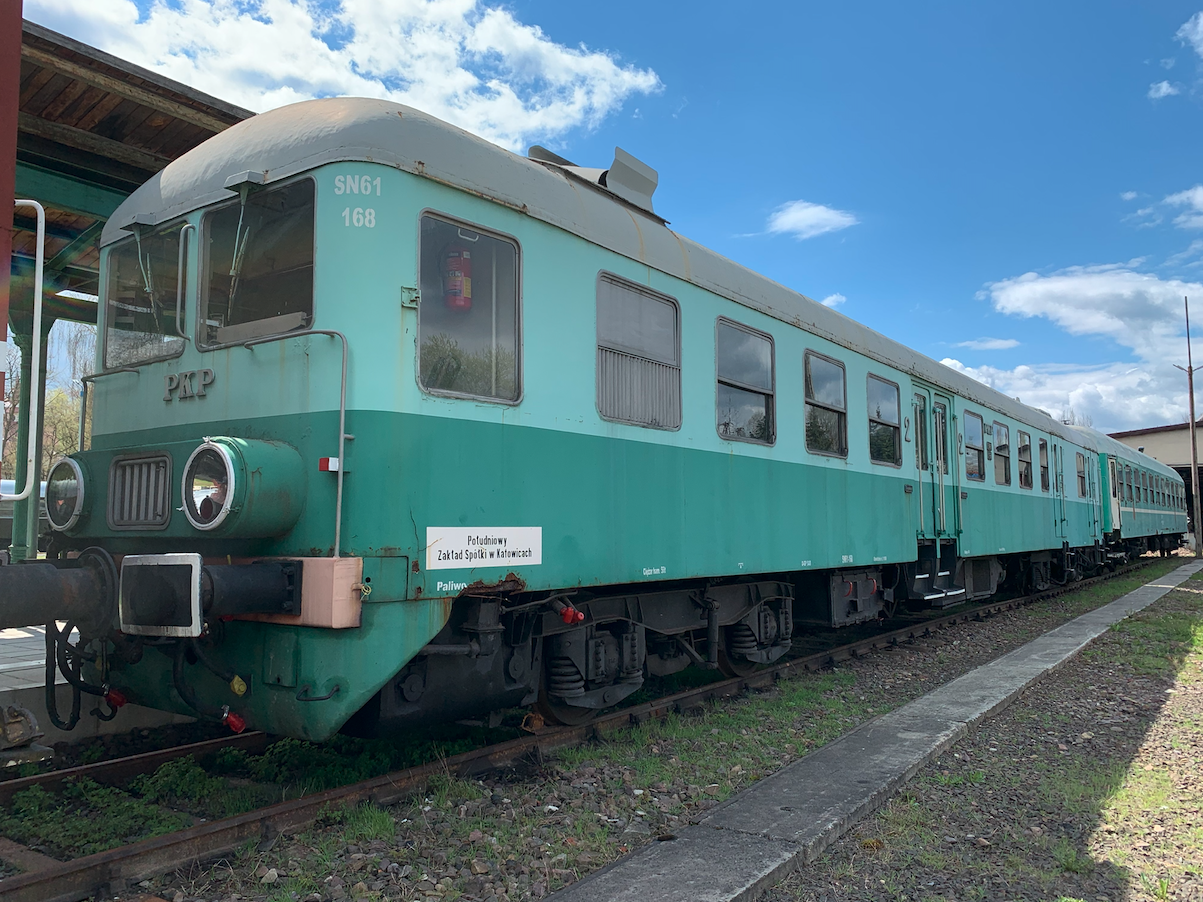Chabówka 2021-05-18
SN61 series railcar.





The SN61 is a railcar that was produced at the Ganz-MAVAG plant in Budapest, Hungary. The "Ganz vállalatok" company was founded in 1844 during the Austro-Hungarian era. It took the name Ganz after Ábrahám Ganz, a Swiss-born Hungarian engineer and iron producer. In 1959, during the socialist era of Hungary, the Ganz company was merged with the MÁVAG company - "Magyar Királyi Államvasutak Gépgyára", or "Machine Factory of the Hungarian Royal State Railways", which was founded in 1874. It is worth mentioning that in 1945, after the nationalization of Hungarian industry, "Królewskie" was removed from the name.
The Ganz-MÁVAG company in Poland is known for deliveries of diesel locomotives of the SM41 series and railcars of the SN52, SN60 and SN61 series. Poland also bought Mávag buses, and later Ikarus buses from the Hungarian company.
The SN61 wagon was custom-built and used by the Polish State Railways (PKP), based on the SN52 and SN60 motor wagons. SN61 series railcars were produced in Hungary from 1960 to 1975. In total, 250 cars of this type were built and all of them went to the Polish State Railways.
A single SN61 rail car can pull up to three trailer cars. The SN61 vehicle found its way to non-electrified local lines with less traffic. Depending on the number of travelers, one, two or three passenger carriages were attached. The wagon can work in multiple traction, up to three wagons together, which was not practiced.
When Poland switched from steam to electric traction, more and more passenger cars were manufactured with an electric heating system. However, there were still many steam-heated passenger cars. As the SN61 railcar had a Clayton RO 500 heating boiler, therefore in winter long-distance trains (express and fast-speed trains, both forms are correct) were compiled as follows: EU07 or ET22 locomotive, SN61 railcar and 8-10 passenger carriages. For example, trains on the route Warsaw - Kraków - Zakopane or Kraków - Wrocław - Poznań - Szczecin ran in this way. Importantly, the heating boiler heated the trailed carriages, and the SN61 car itself was heated from the combustion engine system with water from the cooling system.
The SN61 series wagons were withdrawn from service in the early 90's of the 20th century. A few copies have survived, including two in working order. One in the open-air museum in Chabówka SN61-168. The car is in a classic painting, though a bit faded: light green - dark green. The second SN61-183 is in Szczecin and was renovated in 2014. The car was painted yellow and green.
Construction SN61.
At both ends, the car has driver's control stations and it is possible to control multiple times up to three working cars of this type. The SN61 wagon is not symmetrical. At the front, behind the cabin, there is equipment that is not on the other end. Also in this part there is a bogie and at the other end only a bogie. The diesel engine is housed in the wagon box. In order to suppress the noise, the engine is covered with acoustic screens. This section also includes a fuel tank, a water tank for the boiler and electrical cabinets. Behind the machinery space is a luggage compartment with five seats. Further on, there are two passenger compartments separated by an entrance vestibule. The compartments are class 2 and are divided into smoking and non-smoking rooms as standard. There are 24 seats in each compartment. The layout, type of seats and interior arrangement are the same as in the EN57 series car. The seats are medium soft and covered with leather. Metal (aluminum alloys) luggage racks are located above the windows along the walls. There are six windows in each passenger compartment. There is a heating compartment and a toilet in the further part of the car. All parts of the car are separated by walls with sliding doors. Most of the interior is finished with plywood: painted on the ceiling and polished on the walls. The floor is made of wood and has a thick insulation layer and is covered with linoleum.
Although the car has eight doors (four on one side and four on the other side), there are only one double door on each side of the car located closer to the center of the car. They are double, but limited by a fixed center post. Only these doors have steps to enter from both low and high platforms. The rest of the doors have ladders.
Data T-T SN61:
The service weight of the wagon is 57 800 kg, its total length is 24.215 m, width 2.960 m, height 4.120 m. Wheel diameter 0.940 m. Design speed 108 km / h. The car has 48 seats, plus 5 seats in the luggage compartment. The car can carry a maximum of 111 passengers. The wagon was constructed in the B'2 'axle system.
The drive trolley has a wheelbase of 3,800 m. The transmission from the mechanical transmission to the wheel axle is via cardan shafts. The trolley has a wheelbase of 2,500 m and a typical wagon suspension. The brakes are air. Compressed air tanks and a battery cabinet are located under the wagon's body.
The SN61 wagon has a single Ganz-Jendrassik 12-cylinder 12JV 17/24 diesel engine producing 500hp (368kW) at 1,250 rpm. The last 50 cars of the SN61 series were equipped with a Henschel engine with similar parameters. The drive is transferred from the engine to the wheels by means of a mechanical transmission. The engine takes air from an air intake on the roof. The engine exhaust is also located on the roof.
Written by Karol Placha Hetman
